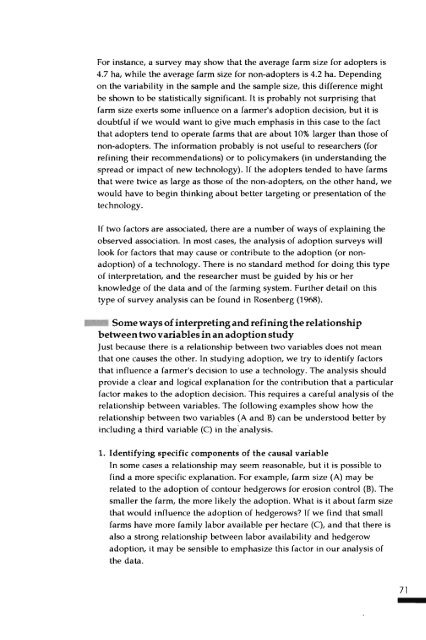The Adoption of Agricultural Technology - Food Security Group
The Adoption of Agricultural Technology - Food Security Group
The Adoption of Agricultural Technology - Food Security Group
Create successful ePaper yourself
Turn your PDF publications into a flip-book with our unique Google optimized e-Paper software.
For instance, a survey may show that the average farm size for adopters is4.7 ha, while the average farm size for non-adopters is 4.2 ha. Dependingon the variability in the sample and the sample size, this difference mightbe shown to be statistically significant. It is probably not surprising thatfarm size exerts some influence on a farmer's adoption decision, but it isdoubtful if we would want to give much emphasis in this case to the factthat adopters tend to operate farms that are about 10% larger than those <strong>of</strong>non-adopters. <strong>The</strong> information probably is not useful to researchers (forrefining their recommendations) or to policymakers (in understanding thespread or impact <strong>of</strong> new technology). If the adopters tended to have farmsthat were twice as large as those <strong>of</strong> the non-adopters, on the other hand, wewould have to begin thinking about better targeting or presentation <strong>of</strong> thetechnology.If two factors are associated, there are a number <strong>of</strong> ways <strong>of</strong> explaining theobserved association. Tn most cases, the analysis <strong>of</strong> adoption surveys willlook for factors that may cause or contribute to the adoption (or nonadoption)<strong>of</strong> a technology. <strong>The</strong>re is no standard method for doing this type<strong>of</strong> interpretation, and the researcher must be guided by his or herknowledge <strong>of</strong> the data and <strong>of</strong> the farming system. Further detail on thistype <strong>of</strong> survey analysis can be found in Rosenberg (1968).Someways <strong>of</strong>interpretingand refiningtherelationshipbetweentwo variables inan adoptionstudyJust because there is a relationship between two variables does not meanthat one causes the other. Tn studying adoption, we try to identify factorsthat influence a farmer's decision to use a technology. <strong>The</strong> analysis shouldprovide a clear and logical explanation for the contribution that a particularfactor makes to the adoption decision. This requires a careful analysis <strong>of</strong> therelationship between variables. <strong>The</strong> following examples show how therelationship between two variables (A and B) can be understood better byincluding a third variable (C) in the'analysis.1. Identifying specific components <strong>of</strong> the causal variableTn some cases a relationship may seem reasonable, but it is possible t<strong>of</strong>ind a more specific explanation. For example, farm size (A) may berelated to the adoption <strong>of</strong> contour hedgerows for erosion control (B). <strong>The</strong>smaller the farm, the more likely the adoption. What is it about farm sizethat would influence the adoption <strong>of</strong> hedgerows? If we find that smallfarms have more family labor available per hectare (C), and that there isalso a strong relationship between labor availability and hedgerowadoption, it may be sensible to emphasize this factor in our analysis <strong>of</strong>the data.71



